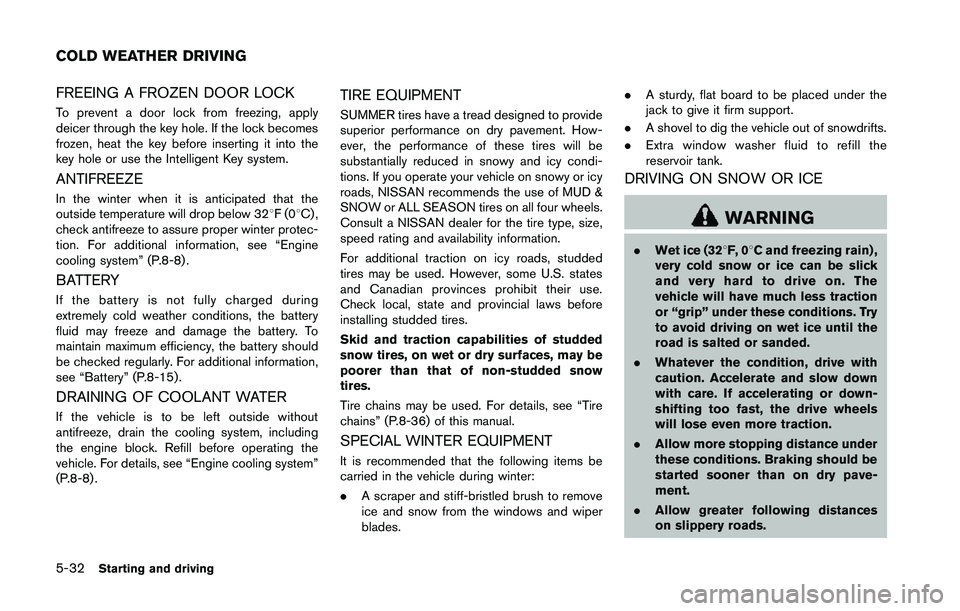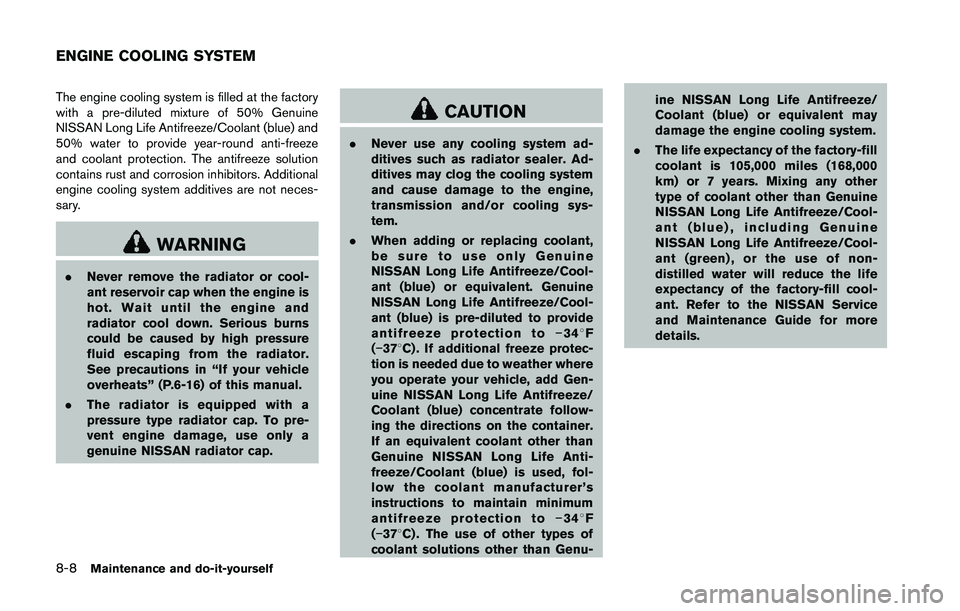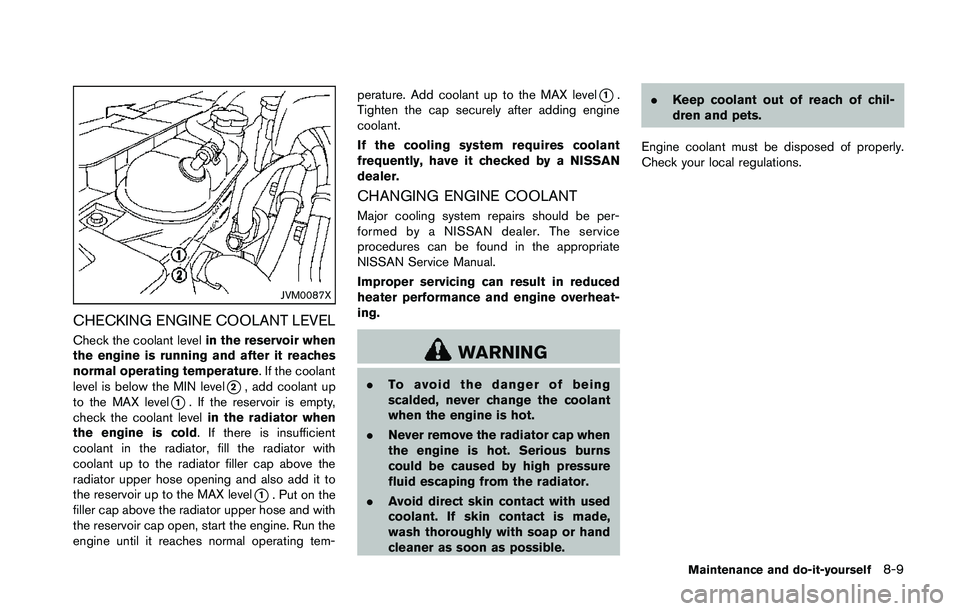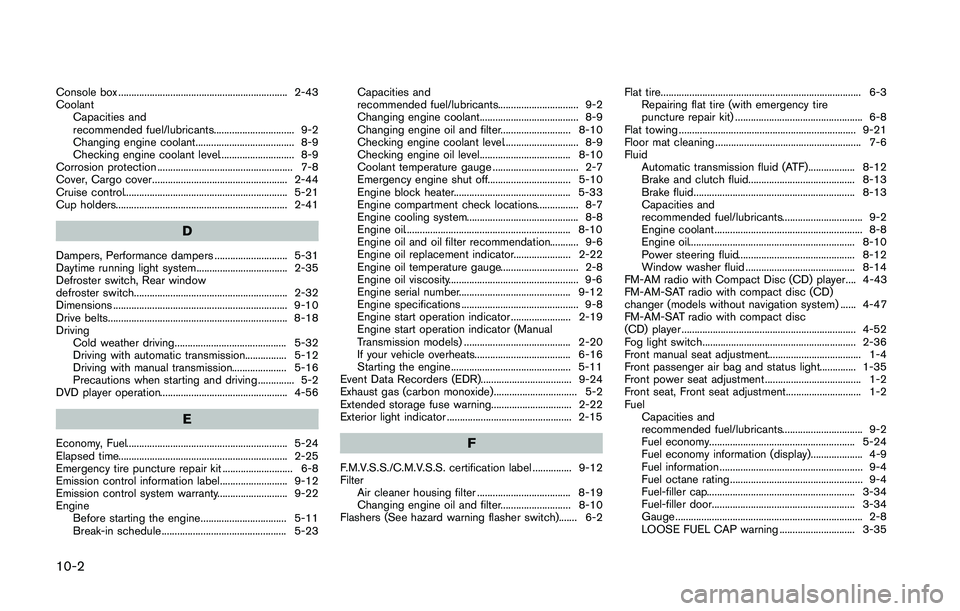2014 NISSAN 370Z cooling
[x] Cancel search: coolingPage 310 of 428

CAUTION
During the first 1,200 miles (2,000 km) ,
follow these recommendations to ob-
tain maximum engine performance and
ensure the future reliability and econo-
my of your new vehicle.
Failure to follow these recommenda-
tions may result in shortened engine
life and reduced engine performance.
. Avoid driving for long periods at constant
speed, either fast or slow. Do not run the
engine over 4,000 rpm.
. Do not accelerate at full throttle in any gear.
. Avoid quick starts.
. Avoid hard braking as much as possible. Follow these easy-to-use Fuel Efficient Driving
Tips to help you achieve the most fuel economy
from your vehicle.
1. Use smooth accelerator and brake pedal
application.
.Avoid rapid starts and stops..Use smooth, gentle accelerator andbrake application whenever possible.
.Maintain constant speed while commut-
ing and coast whenever possible.
2. Maintain constant speed.
.Look ahead to try and anticipate and minimize stops.
.Synchronizing your speed with traffic
lights allows you to reduce your number
of stops.
.Maintaining a steady speed can minimize red light stops and improve fuel effi-
ciency.
3. Use air conditioning (A/C) at higher vehicle speeds.
.Below 40 MPH (64 km/h), it is moreefficient to open windows to cool the
vehicle due to reduced engine load.
.Above 40 MPH (64 km/h) , it is moreefficient to use A/C to cool the vehicle
due to increased aerodynamic drag.
.Recirculating the cool air in the cabinwhen the A/C is on reduces cooling load.
4. Drive at economical speeds and distances.
.Observing the speed limit and not ex- ceeding 60 MPH (97 km/h) (where
legally allowed) can improve fuel effi-
ciency due to reduced aerodynamic
drag.
.Maintaining a safe following distancebehind other vehicles reduces unneces-
sary braking.
.Safely monitoring traffic to anticipatechanges in speed permits reduced brak-
ing and smooth acceleration changes.
.Select a gear range suitable to road conditions.
5. Use cruise control.
.Using cruise control during highway driving helps maintain a steady speed.
.Cruise control is particularly effective in providing fuel savings when driving on
flat terrains.
6. Plan for the shortest route.
.Utilize a map or navigation system to determine the best route to save time.
7. Avoid idling.
.Shutting off your engine when safe for stops exceeding 30-60 seconds saves
Starting and driving5-23
BREAK-IN SCHEDULE FUEL EFFICIENT DRIVING TIPS
Page 319 of 428

FREEING A FROZEN DOOR LOCK
To prevent a door lock from freezing, apply
deicer through the key hole. If the lock becomes
frozen, heat the key before inserting it into the
key hole or use the Intelligent Key system.
ANTIFREEZE
In the winter when it is anticipated that the
outside temperature will drop below 328F(08C) ,
check antifreeze to assure proper winter protec-
tion. For additional information, see “Engine
cooling system” (P.8-8).
BATTERY
If the battery is not fully charged during
extremely cold weather conditions, the battery
fluid may freeze and damage the battery. To
maintain maximum efficiency, the battery should
be checked regularly. For additional information,
see “Battery” (P.8-15) .
DRAINING OF COOLANT WATER
If the vehicle is to be left outside without
antifreeze, drain the cooling system, including
the engine block. Refill before operating the
vehicle. For details, see “Engine cooling system”
(P.8-8) .
TIRE EQUIPMENT
SUMMER tires have a tread designed to provide
superior performance on dry pavement. How-
ever, the performance of these tires will be
substantially reduced in snowy and icy condi-
tions. If you operate your vehicle on snowy or icy
roads, NISSAN recommends the use of MUD &
SNOW or ALL SEASON tires on all four wheels.
Consult a NISSAN dealer for the tire type, size,
speed rating and availability information.
For additional traction on icy roads, studded
tires may be used. However, some U.S. states
and Canadian provinces prohibit their use.
Check local, state and provincial laws before
installing studded tires.
Skid and traction capabilities of studded
snow tires, on wet or dry surfaces, may be
poorer than that of non-studded snow
tires.
Tire chains may be used. For details, see “Tire
chains” (P.8-36) of this manual.
SPECIAL WINTER EQUIPMENT
It is recommended that the following items be
carried in the vehicle during winter:
. A scraper and stiff-bristled brush to remove
ice and snow from the windows and wiper
blades. .
A sturdy, flat board to be placed under the
jack to give it firm support.
. A shovel to dig the vehicle out of snowdrifts.
. Extra window washer fluid to refill the
reservoir tank.
DRIVING ON SNOW OR ICE
Page 361 of 428

The engine cooling system is filled at the factory
with a pre-diluted mixture of 50% Genuine
NISSAN Long Life Antifreeze/Coolant (blue) and
50% water to provide year-round anti-freeze
and coolant protection. The antifreeze solution
contains rust and corrosion inhibitors. Additional
engine cooling system additives are not neces-
sary.
Page 362 of 428

JVM0087X
CHECKING ENGINE COOLANT LEVEL
Check the coolant levelin the reservoir when
the engine is running and after it reaches
normal operating temperature. If the coolant
level is below the MIN level
*2, add coolant up
to the MAX level
*1. If the reservoir is empty,
check the coolant level in the radiator when
the engine is cold. If there is insufficient
coolant in the radiator, fill the radiator with
coolant up to the radiator filler cap above the
radiator upper hose opening and also add it to
the reservoir up to the MAX level
*1. Put on the
filler cap above the radiator upper hose and with
the reservoir cap open, start the engine. Run the
engine until it reaches normal operating tem- perature. Add coolant up to the MAX level
*1.
Tighten the cap securely after adding engine
coolant.
If the cooling system requires coolant
frequently, have it checked by a NISSAN
dealer.
CHANGING ENGINE COOLANT
Major cooling system repairs should be per-
formed by a NISSAN dealer. The service
procedures can be found in the appropriate
NISSAN Service Manual.
Improper servicing can result in reduced
heater performance and engine overheat-
ing.
Page 421 of 428

Console box ................................................................. 2-43
CoolantCapacities and
recommended fuel/lubricants............................... 9-2
Changing engine coolant...................................... 8-9
Checking engine coolant level............................. 8-9
Corrosion protection .................................................... 7-8
Cover, Cargo cover.................................................... 2-44
Cruise control............................................................... 5-21
Cup holders.................................................................. 2-41
D
Dampers, Performance dampers ............................ 5-31
Daytime running light system................................... 2-35
Defroster switch, Rear window
defroster switch........................................................... 2-32
Dimensions ................................................................... 9-10
Drive belts..................................................................... 8-18
Driving Cold weather driving........................................... 5-32
Driving with automatic transmission................ 5-12
Driving with manual transmission..................... 5-16
Precautions when starting and driving .............. 5-2
DVD player operation................................................. 4-56
E
Economy, Fuel.............................................................. 5-24
Elapsed time................................................................. 2-25
Emergency tire puncture repair kit ........................... 6-8
Emission control information label.......................... 9-12
Emission control system warranty........................... 9-22
Engine Before starting the engine................................. 5-11
Break-in schedule ................................................ 5-23 Capacities and
recommended fuel/lubricants............................... 9-2
Changing engine coolant...................................... 8-9
Changing engine oil and filter........................... 8-10
Checking engine coolant level............................. 8-9
Checking engine oil level................................... 8-10
Coolant temperature gauge ................................. 2-7
Emergency engine shut off................................ 5-10
Engine block heater............................................. 5-33
Engine compartment check locations................ 8-7
Engine cooling system........................................... 8-8
Engine oil................................................................ 8-10
Engine oil and oil filter recommendation........... 9-6
Engine oil replacement indicator...................... 2-22
Engine oil temperature gauge.............................. 2-8
Engine oil viscosity.................................................. 9-6
Engine serial number........................................... 9-12
Engine specifications ............................................. 9-8
Engine start operation indicator ....................... 2-19
Engine start operation indicator (Manual
Transmission models) ......................................... 2-20
If your vehicle overheats..................................... 6-16
Starting the engine .............................................. 5-11
Event Data Recorders (EDR)................................... 9-24
Exhaust gas (carbon monoxide)................................ 5-2
Extended storage fuse warning............................... 2-22
Exterior light indicator ................................................ 2-15F
F.M.V.S.S./C.M.V.S.S. certification label ............... 9-12
Filter Air cleaner housing filter .................................... 8-19
Changing engine oil and filter........................... 8-10
Flashers (See hazard warning flasher switch)....... 6-2 Flat tire............................................................................. 6-3
Repairing flat tire (with emergency tire
puncture repair kit) ................................................. 6-8
Flat towing .................................................................... 9-21
Floor mat cleaning ........................................................ 7-6
Fluid Automatic transmission fluid (ATF).................. 8-12
Brake and clutch fluid......................................... 8-13
Brake fluid.............................................................. 8-13
Capacities and
recommended fuel/lubricants............................... 9-2
Engine coolant......................................................... 8-8
Engine oil................................................................ 8-10
Power steering fluid............................................. 8-12
Window washer fluid .......................................... 8-14
FM-AM radio with Compact Disc (CD) player.... 4-43
FM-AM-SAT radio with compact disc (CD)
changer (models without navigation system) ...... 4-47
FM-AM-SAT radio with compact disc
(CD) player ................................................................... 4-52
Fog light switch........................................................... 2-36
Front manual seat adjustment.................................... 1-4
Front passenger air bag and status light.............. 1-35
Front power seat adjustment ..................................... 1-2
Front seat, Front seat adjustment............................. 1-2
Fuel
Capacities and
recommended fuel/lubricants............................... 9-2
Fuel economy........................................................ 5-24
Fuel economy information (display).................... 4-9
Fuel information ....................................................... 9-4
Fuel octane rating ................................................... 9-4
Fuel-filler cap......................................................... 3-34
Fuel-filler door....................................................... 3-34
Gauge ........................................................................ 2-8
LOOSE FUEL CAP warning ............................. 3-35